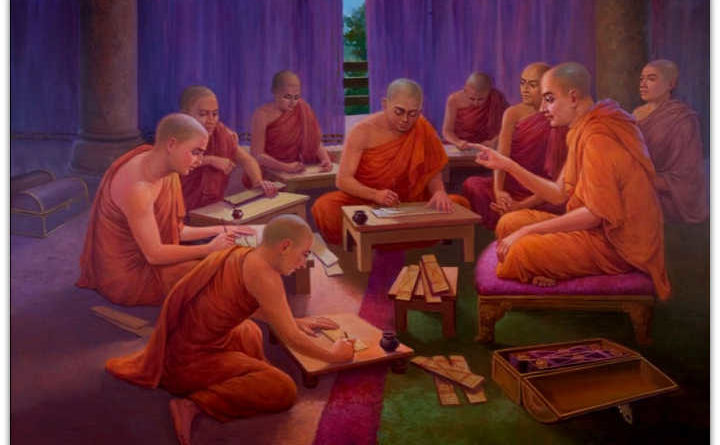Nội Dung Chính
The Digha Nikaya (“Collection of Long Discourses”) is the first of the five nikayas (collections) in the Sutta Pitaka. Some of the most commonly referenced suttas from the Digha Nikaya include the Maha-parinibbana Sutta (DN 16), which described the final days and death of the Buddha, the Sigalovada Sutta (DN 31) in which the Buddha discusses ethics and practices for lay followers, and the Samaññaphala (DN 2), Brahmajala Sutta (DN 1) which describes and compares the point-of-view of Buddha and other ascetics in India about the universe and time (past, present, and future); and Potthapada Sutta (DN 9), which describe the benefits and practice of samatha meditation (calm meditation).
The Digha Nikaya consists of 34 discourses, broken into three vaggas (groups):
Contents
Silakkhandha-vagga
The Division Concerning Morality (13 suttas)
- Brahmajala Sutta (1) “The Great Net” or the universal net(of the world), in which are caught all beings like fish & the 62 heretical forms of speculation concerning the world and the self taught by other teachers of the time.
- Samannaphala Sutta (2) “The Fruits of the Hermit Life”. The Buddha explains to King Ajatasattu the advantages of joining the Buddhist Order and renouncing the life of the world.
- Ambattha Sutta (3) Pride of birth and its fall. A dialogue with Ambattha on caste. Contains reference to the legend of King Okkaka, the traditional founder of the Sakya clan.
- Sonadanda Sutta (4) Dialogue with the Brahmin Sonadanda on the characteristics of the true brahmin.
- Kutadanta Sutta (5) Dialogue with the Brahmin Kutadanta condemning animal sacrifice.
- Mahali Sutta (6) Dialogue with Mahali on deva like vision and hearing and the attainment of full enlightenment.
- Jaliya Sutta (7) On the nature of the life principle as compared with the body.
- Kassapasihanada Sutta (8) A dialogue with the naked ascetic Kassapa against self-mortification.
- Potthapada Sutta (9) A discussion with Potthapada on the nature of the soul, in which the Buddha states the question to be irrelevant and not conducive to enlightenment.
- Subha Sutta (Digna Nikaya) (10) A discourse, attributed to Ananda, on conduct, concentration and wisdom.
- Kevaddha Sutta (11) The Buddha refuses to allow a bhikkhu to perform a miracle. Story of the monk who visited the devas (deities) to question them. A description of Nirvana/Moksha state is also presented.
- Lohicca Sutta (12) Dialogue with the Brahmin Lohicca on the ethics of teaching.
- Tevijja Sutta (13) On the futility of a knowledge of the Vedas as means to attaining companionship with Brahma.
Maha-vagga
The Large Division (10 suttas)
- Maha-padana Sutta (14) The Sublime Story of the Buddha Gotama and his six predecessors; also the Discourse on the Buddha Vipassi; his descent from the Tusita heaven to the commencement of his mission.
- Maha-nidana Sutta (15) On the Chain of Causation and theories of the soul.
- Maha-parinibbana Sutta (16) The Great Discourse of the record of the passing of the Tathagata into Parinibbana.
- Maha Sudassana Sutta (17) The Great King of Glory. The story of a previous existence of the Buddha, as King Sudassana. Told by the Buddha on his death-bed.
- Janavasabha Sutta (18) The Buddha relates the story of the yakkha Janavasabha to the people of Nadika.
- Maha Govinda Sutta (19) The heavenly musician Pancasikha relates the story of Maha Govinda to the Buddha, who states that he himself was Maha Govinda.
- Maha-samaya Sutta (20) The Devas of the Pure Abode and their evolution.
- Sakkapanha Sutta (21) Sakka, the lord of devas visits the Buddha, and learns from him that everything that originates is subject also to dissolution.
- Maha-satipatthana Sutta (22) Discourse on the Four Great Meditations, on the body, feelings thoughts and states of mind. With a commentary on the Four Truths.
- Payasi Sutta (23) Payasi disputes rebirth/reincarnation & reward of actions(kamma/karma) but experiences it himself.
Patika-vagga
The Patika Division (11 suttas)
- Patika Sutta (24) Story of the disciple who follows other teachers because the Buddha does not work miracles or teach the origin of things.
- Udumbarikasihanada Sutta (25) The Buddha discusses asceticism with the ascetic Nigrodha.
- Cakkavattisihanada Sutta (26) Story of the universal king, the corruption of morals and their restoration, and the coming of the future Buddha Metteya.
- Agganna Sutta (27) A discussion on caste, and an exposition on the origin of things (as in Sutta 24) down to the origin of the four castes.
- Sampasadaniya Sutta (28) A dialogue of the Buddha with Sariputta, who describes the Teaching of the Buddha and asserts his faith in him.
- Pasadika Sutta (29) The Delectable Discourse. Discourse of the Buddha on the perfect and the imperfect teacher.
- Lakkhana Sutta (30) On the 32 marks of a Great Man.
- Sigalovada Sutta (31) The Sigala homily on the duties of the householder to the six classes of persons.
- Atanatiya Sutta (32) On the Four Great Kings and their spell for protection against evil.
- Sangiti Sutta (33) Sariputta outlines the principles of the Teaching in ten numerical groups.
- Dasuttara Sutta (34) Sariputta outlines the doctrine in tenfold series.
Download/View English Translation
Freely available translation from Pali Text Society.
Note : Some files are divided into parts a,b,c etc. because of max. upload limit of 10Mb
Original Pali Version
(From www.tipitaka.org)
Click the link below to access the original Digha Nikaya files in Pali language, the language spoken by Buddha.
Source: https://tipitaka.fandom.com/wiki/Digha_Nikaya

